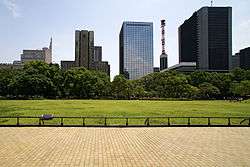Hibiya Park
| Hibiya park | |
|---|---|
 | |
| Location | Chiyoda, Tokyo, Japan |
| Coordinates | 35°40′25.3″N 139°45′21.8″E / 35.673694°N 139.756056°ECoordinates: 35°40′25.3″N 139°45′21.8″E / 35.673694°N 139.756056°E |
| Area | 161,636.66 square metres (39.94129 acres) |
| Created | 1903 |
Hibiya Park (日比谷公園 Hibiya Kōen) is a park in Chiyoda City, Tokyo, Japan. It covers an area of 161,636.66m2 (40 acre) between the east gardens of the Imperial Palace to the north, the Shinbashi district to the southeast and the Kasumigaseki government district to the west.
History
The land was occupied by the estates of the Mōri clan and Nabeshima clan during the Edo period, and was used for army maneuvers during the Meiji period. It was converted to a park and opened to the public on June 1, 1903.[1]
On September 5, 1905 the park was the origin of the Hibiya Incendiary Incident, a major citywide riot that erupted in protest of the terms of the Treaty of Portsmouth which ended the Russo-Japanese War of 1904-1905. The Riots lasted two days resulting in seventeen people being killed and 331 arrested, as well a large amount of property damage. The riots were not only against the unfavorable terms of the treaty but also due to bureaucrats who refused accept he will of the people in regards to Foreign policy.[2]
The park is famous for the Shisei Kaikan (市政会館), a brick building built in Gothic style in 1929, which once housed the Domei Tsushin state wire service and its postwar successors Kyodo News and Jiji Press. This Park is also home to the "Risky Ginkgo," A Ginkgo tree that is about 500 years old and almost lost the park's designer his job when he fought to save the tree in 1901.[3]
The park is also known for its open-air concert venue, Hibiya Open-Air Concert Hall (日比谷野外音楽堂), and for its tennis courts (for which reservations are hotly contested due to their proximity to the financial and government districts). World War II took a toll on the park when almost all the trees and fenceing was used for the war effort.[4]
Contents
Surrounding buildings
- Attorneys' Hall (Japan Federation of Bar Associations headquarters)
- Fukoku Seimei Building
- Imperial Hotel, Tokyo
- Ministry of the Environment
- Ministry of Health, Labour and Welfare
- Ministry of Justice *Mizuho Bank Building
- Nissay Theatre
- NTT Hibiya Building
- Shinsei Bank Building
- Sumitomo Mitsui Banking Corporation Building
Gallery
 Hibiya Park Lake and Wisteria Grove
Hibiya Park Lake and Wisteria Grove_02.jpg) Shisei Kaikan, former home of Japan's newswires
Shisei Kaikan, former home of Japan's newswires- Rai stone in Hibiya park
 Ongaku-do, Hibiya Park, Tokyo, 1909
Ongaku-do, Hibiya Park, Tokyo, 1909
External links
| Wikimedia Commons has media related to Hibiya Park. |
| Preceded by
none |
Emperor's Cup Final Venue
1921 |
Succeeded by
Toshima-shihan Ground Tokyo |
- ↑ Kameda, Masaaki (2013-06-01). "Hibiya Park celebrates first 110 years this weekend". The Japan Times Online. ISSN 0447-5763. Retrieved 2018-03-20.
- ↑ 1952-, Gordon, Andrew,. A modern history of Japan : from Tokugawa times to the present (Third ed.). New York. ISBN 9780199930159. OCLC 826458560.
- ↑ https://www.japan-talk.com/jt/new/hibiya-park
- ↑ https://www.japanvisitor.com/japan-parks-gardens/hibiya-park
| Wikimedia Commons has media related to Hibiya Park. |
